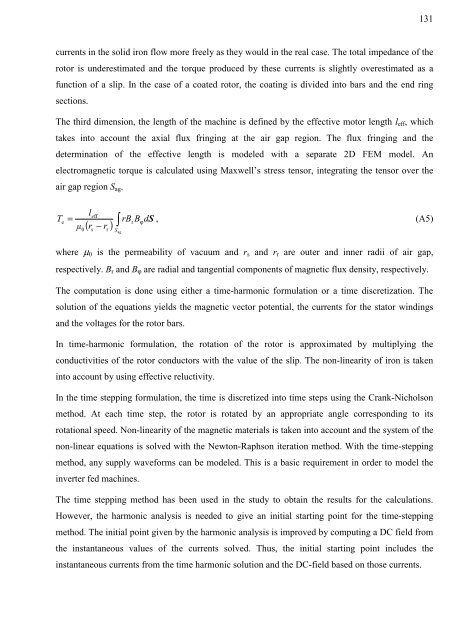Design and Voltage Supply of High-Speed Induction - Aaltodoc
Design and Voltage Supply of High-Speed Induction - Aaltodoc
Design and Voltage Supply of High-Speed Induction - Aaltodoc
Create successful ePaper yourself
Turn your PDF publications into a flip-book with our unique Google optimized e-Paper software.
currents in the solid iron flow more freely as they would in the real case. The total impedance <strong>of</strong> the<br />
rotor is underestimated <strong>and</strong> the torque produced by these currents is slightly overestimated as a<br />
function <strong>of</strong> a slip. In the case <strong>of</strong> a coated rotor, the coating is divided into bars <strong>and</strong> the end ring<br />
sections.<br />
The third dimension, the length <strong>of</strong> the machine is defined by the effective motor length leff, which<br />
takes into account the axial flux fringing at the air gap region. The flux fringing <strong>and</strong> the<br />
determination <strong>of</strong> the effective length is modeled with a separate 2D FEM model. An<br />
electromagnetic torque is calculated using Maxwell’s stress tensor, integrating the tensor over the<br />
air gap region Sag.<br />
l<br />
T =<br />
S , (A5)<br />
e<br />
( ) ∫ eff rBrBϕ<br />
d<br />
0 rs<br />
− r<br />
Sag<br />
where µ0 is the permeability <strong>of</strong> vacuum <strong>and</strong> rs <strong>and</strong> rr are outer <strong>and</strong> inner radii <strong>of</strong> air gap,<br />
respectively. Br <strong>and</strong> Bϕ are radial <strong>and</strong> tangential components <strong>of</strong> magnetic flux density, respectively.<br />
The computation is done using either a time-harmonic formulation or a time discretization. The<br />
solution <strong>of</strong> the equations yields the magnetic vector potential, the currents for the stator windings<br />
<strong>and</strong> the voltages for the rotor bars.<br />
In time-harmonic formulation, the rotation <strong>of</strong> the rotor is approximated by multiplying the<br />
conductivities <strong>of</strong> the rotor conductors with the value <strong>of</strong> the slip. The non-linearity <strong>of</strong> iron is taken<br />
into account by using effective reluctivity.<br />
In the time stepping formulation, the time is discretized into time steps using the Crank-Nicholson<br />
method. At each time step, the rotor is rotated by an appropriate angle corresponding to its<br />
rotational speed. Non-linearity <strong>of</strong> the magnetic materials is taken into account <strong>and</strong> the system <strong>of</strong> the<br />
non-linear equations is solved with the Newton-Raphson iteration method. With the time-stepping<br />
method, any supply waveforms can be modeled. This is a basic requirement in order to model the<br />
inverter fed machines.<br />
The time stepping method has been used in the study to obtain the results for the calculations.<br />
However, the harmonic analysis is needed to give an initial starting point for the time-stepping<br />
method. The initial point given by the harmonic analysis is improved by computing a DC field from<br />
the instantaneous values <strong>of</strong> the currents solved. Thus, the initial starting point includes the<br />
instantaneous currents from the time harmonic solution <strong>and</strong> the DC-field based on those currents.<br />
131
















